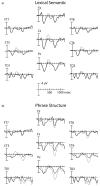An ERP study of regular and irregular English past tense inflection
- PMID: 17070703
- PMCID: PMC1988695
- DOI: 10.1016/j.neuroimage.2006.09.007
An ERP study of regular and irregular English past tense inflection
Abstract
Compositionality is a critical and universal characteristic of human language. It is found at numerous levels, including the combination of morphemes into words and of words into phrases and sentences. These compositional patterns can generally be characterized by rules. For example, the past tense of most English verbs ("regulars") is formed by adding an -ed suffix. However, many complex linguistic forms have rather idiosyncratic mappings. For example, "irregular" English verbs have past tense forms that cannot be derived from their stems in a consistent manner. Whether regular and irregular forms depend on fundamentally distinct neurocognitive processes (rule-governed combination vs. lexical memorization), or whether a single processing system is sufficient to explain the phenomena, has engendered considerable investigation and debate. We recorded event-related potentials while participants read English sentences that were either correct or had violations of regular past tense inflection, irregular past tense inflection, syntactic phrase structure, or lexical semantics. Violations of regular past tense and phrase structure, but not of irregular past tense or lexical semantics, elicited left-lateralized anterior negativities (LANs). These seem to reflect neurocognitive substrates that underlie compositional processes across linguistic domains, including morphology and syntax. Regular, irregular, and phrase structure violations all elicited later positivities that were maximal over midline parietal sites (P600s), and seem to index aspects of controlled syntactic processing of both phrase structure and morphosyntax. The results suggest distinct neurocognitive substrates for processing regular and irregular past tense forms: regulars depending on compositional processing, and irregulars stored in lexical memory.
Figures



Similar articles
-
The Past Tense Debate Revisited: Electrophysiological Evidence for Subregularities of Irregular Verb Inflection.J Cogn Neurosci. 2015 Sep;27(9):1870-85. doi: 10.1162/jocn_a_00818. Epub 2015 Apr 22. J Cogn Neurosci. 2015. PMID: 25901449
-
Interpreting dissociations between regular and irregular past-tense morphology: evidence from event-related potentials.Cogn Affect Behav Neurosci. 2008 Jun;8(2):178-94. doi: 10.3758/cabn.8.2.178. Cogn Affect Behav Neurosci. 2008. PMID: 18589508 Free PMC article.
-
FMRI of past tense processing: the effects of phonological complexity and task difficulty.J Cogn Neurosci. 2006 Feb;18(2):278-97. doi: 10.1162/089892906775783633. J Cogn Neurosci. 2006. PMID: 16494687 Free PMC article.
-
Overregularization in language acquisition.Monogr Soc Res Child Dev. 1992;57(4):1-182. Monogr Soc Res Child Dev. 1992. PMID: 1518508 Review.
-
Past Tense Production in Children With and Without Specific Language Impairment Across Germanic Languages: A Meta-Analysis.J Speech Lang Hear Res. 2015 Aug;58(4):1326-40. doi: 10.1044/2015_JSLHR-L-14-0348. J Speech Lang Hear Res. 2015. PMID: 26049065 Free PMC article. Review.
Cited by
-
An Event-related Potential Study of Second Language Semantic and Syntactic Processing: Evidence From the Declarative/Procedural Model.Basic Clin Neurosci. 2020 Nov-Dec;11(6):841-854. doi: 10.32598/bcn.11.6.2401.1. Epub 2020 Nov 1. Basic Clin Neurosci. 2020. PMID: 33850621 Free PMC article.
-
Syntax, concepts, and logic in the temporal dynamics of language comprehension: evidence from event-related potentials.Neuropsychologia. 2010 May;48(6):1525-42. doi: 10.1016/j.neuropsychologia.2010.01.013. Epub 2010 Feb 4. Neuropsychologia. 2010. PMID: 20138065 Free PMC article.
-
Changes in functional connectivity within the fronto-temporal brain network induced by regular and irregular Russian verb production.Front Hum Neurosci. 2015 Feb 18;9:36. doi: 10.3389/fnhum.2015.00036. eCollection 2015. Front Hum Neurosci. 2015. PMID: 25741262 Free PMC article.
-
Processing Aspectual Agreement in a Language with Limited Morphological Inflection by Second Language Learners: An ERP Study of Mandarin Chinese.Brain Sci. 2022 Apr 21;12(5):524. doi: 10.3390/brainsci12050524. Brain Sci. 2022. PMID: 35624911 Free PMC article.
-
Sensitivity to Inflectional Morphemes in the Absence of Meaning: Evidence from a Novel Task.J Psycholinguist Res. 2019 Jun;48(3):747-767. doi: 10.1007/s10936-019-09629-y. J Psycholinguist Res. 2019. PMID: 30840217 Free PMC article.
References
-
- Allen M, Badecker W, Osterhout L. Morphological analysis in sentence processing: An ERP study. Language & Cognitive Processes. 2003;18:405–430.
-
- Barber H, Carreiras M. Grammatical gender and number agreement in Spanish: an ERP comparison. J Cogn Neurosci. 2005;17:137–153. - PubMed
-
- Barrett SE, Rugg MD. Event-related potentials and the phonological matching of picture names. Brain Lang. 1990;38:424–437. - PubMed
-
- Bartke S, Rosler F, Streb J, Wiese R. An ERP-study of German 'irregular' morphology. Journal of Neurolinguistics. 2005;18:29–55.
-
- Bentin S, Mouchetant-Rostaing Y, Giard MH, Echallier JF, Pernier J. ERP manifestations of processing printed words at different psycholinguistic levels: time course and scalp distribution. Journal of Cognitive Neuroscience. 1999;11:235–260. - PubMed
Publication types
MeSH terms
Grants and funding
LinkOut - more resources
Full Text Sources
Miscellaneous

